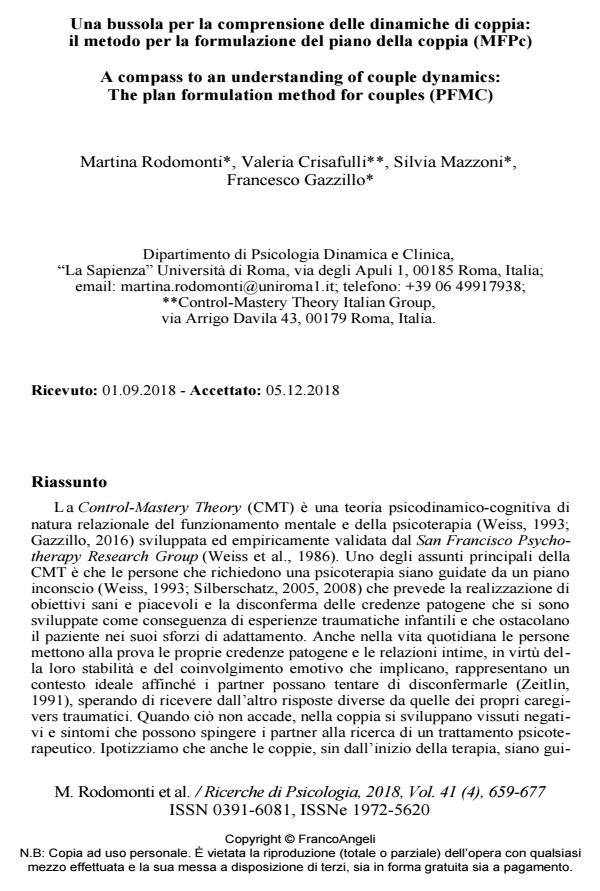A compass to an understanding of couple dynamics: The plan formulation method for couples (PFMC)
Journal title RICERCHE DI PSICOLOGIA
Author/s Martina Rodomonti, Valeria Crisafulli, Silvia Mazzoni, Francesco Gazzillo
Publishing Year 2019 Issue 2018/4
Language Italian Pages 19 P. 659-677 File size 261 KB
DOI 10.3280/RIP2018-004007
DOI is like a bar code for intellectual property: to have more infomation
click here
Below, you can see the article first page
If you want to buy this article in PDF format, you can do it, following the instructions to buy download credits

FrancoAngeli is member of Publishers International Linking Association, Inc (PILA), a not-for-profit association which run the CrossRef service enabling links to and from online scholarly content.
Control-Mastery Theory (CMT) is a cognitive-psychodynamic theory of psy-chological functioning and psychopathology (Weiss, 1993; Gazzillo, 2016), em-pirically validated by the San Francisco Psychotherapy Research Group (1986). A central tenet of CMT is that people who seek for psychotherapy are guided by an unconscious plan (Weiss, 1993; Silberschatz, 2005, 2008). Such unconscious plan provides for the realization of healthy and pleasant goals and the discon-firmation of the pathogenic beliefs that have developed as a consequence of childhood traumatic experiences and which hinder the patient in his adaptation efforts. Even in everyday life people test their pathogenic beliefs and intimate relationships, thanks to the stability and the emotional involvement that they imply, represent an ideal context for the partners to try to disconfirm their respec-tive pathogenic beliefs (Zeitlin, 1991), hoping to receive different responses from those received by their traumatic caregivers. When this does not happen, the couple develops negative experiences and symptoms, which may encourage partners to seek for a psychotherapeutic treatment. We hypothesize that not only individuals but also couples are guided by an unconscious plan at the beginning of the therapy and the aim of our work is to provide guidelines for the Formula-tion of the Couple’s Plan. The couple’s plan includes goals, obstructions, individ-ual and couple traumas, vicious circles such as the matching of pathogenic be-liefs of both partners that generate dysfunctional patterns, virtuous circles which guarantee members of the couple to feel safe in the relationship, and finally the insights. The formulation of each component will be explained with the help of a clinical case and the results of the self-report measures used - the Interpersonal Guilt Rating Scale-15 (IGRS-15, Gazzillo et al., 2017) and the Pathogen-ic/Problematic Beliefs Scale (PBS; Silberschatz, 2016) - will be reported. The couple’s plan represents a method of assessment and intervention in the work with conjugal and parental dyads, which is useful both to the therapist - especial-ly to the young therapist – to orientate himself in the clinical work, both to the researcher, to understand the dysfunctional dynamics underlying individual and dyadic suffering.
Keywords: Control-Mastery Theory, couple therapy, couple’s plan, plan for-mulation method for couples.
- Description and First Steps Toward the Empirical Validation of the Plan Formulation Method for Couples Martina Rodomonti, Valeria Crisafulli, Sveva Angrisani, Emma De Luca, Silvia Mazzoni, Francesco Gazzillo, in Journal of Contemporary Psychotherapy /2022 pp.227
DOI: 10.1007/s10879-022-09534-x
Martina Rodomonti, Valeria Crisafulli, Silvia Mazzoni, Francesco Gazzillo, Una bussola per la comprensione delle dinamiche di coppia: il metodo per la formulazione del piano della coppia (MFPc) in "RICERCHE DI PSICOLOGIA " 4/2018, pp 659-677, DOI: 10.3280/RIP2018-004007